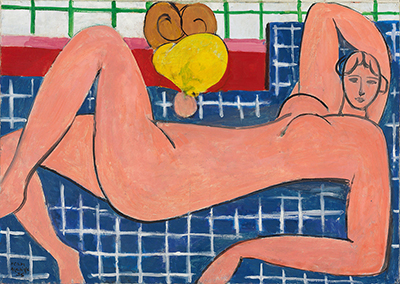This bright portrait was completed by Henri Matisse in 1935 and is now a part of the highly respected collection of the The Baltimore Museum of Art, Baltimore, USA.
This composition features a figure lying back upon a blue piece of furniture, with a white checked pattern. Behind is a wall with a green and white set of tiles. One noticed instantly the contrast in size between the reclining woman's head and the rest of her body - her arms are elongated in a way that reminds many of art styles from many centuries ago. It is entirely modern and perhaps abstract to capture this model in this way, and is a sign of how Matisse wanted to work in this period of his career. These bold flat colours feature almost no detail of the figure, just outlines marked by darker lines which provide a semblance of form. African art can be said to be the most direct influence upon this work, but Matisse himself would call on all manner of different sources of inspiration during his long and distinguished career.
Large Reclining Nude, sometimes known as Pink Nude, bears the hallmarks of a number of other famous Matisse paintings, such as his Blue Nude series, where just a single colour is used to produce the different figures. You can also see the technique of reducing detail down to the lowest level of abstraction within Dance as well, though with more of an orange tone for the skin in that example. He liked to work in this style with huge canvases, leaving behind something akin to a pre-historic cave painting or mural that would overpower the viewer with colour and imagination. That said, some of the larger pieces were specifically requested to be that size, and sometimes he still preferred to work on smaller canvases. The artwork found here was just under a metre in width, which is fairly standard for his overall career.
Whilst we can see the use of oils here in the slightly varying tones of colour within each element of the body, there is a clear movement towards his later cut-out work, where ultimately just one shade would be used each time. He would move so far into abstraction that oils or acrylics were not even needed anymore - he could simply cut out shapes from card and use them instead to produce the different figures. Perhaps most would prefer this style, where individual strokes of the paintbrush can be seen, but there was also a purity to the later cut out series and it also helped Matisse to continue to work even after his health had deteriorated substantially.





